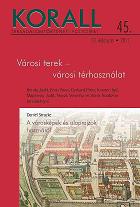A foglalkozás topográfiája. A társadalmi tértől a személyes térig: a társadalmi mobilitás térbeli elemei a 15. századi Pozsonyban
The Topography of Craft. From Social Space to Personal Space: the Spatial Elements of Social Mobility in Fifteenth-Century Pressburg
Author(s): Judit MajorossySubject(s): History
Published by: KORALL Társadalomtörténeti Egyesület
Summary/Abstract: On the basis of Henri Lefebvre’s basic suggestion that space is a social production, many scholars have already described the city of late medieval Europe as “a spatial being, not just a creation in space but also a creation of space,” and stated that “the space of the medieval city was itself re-divided, imagined and lived as a collection of distinct spaces.” On the other hand, “the urban space was a reflection of the needs of merchants and of the artisans primarily, and may thus well be considered as a very close expression of the economic organization.” Consequently, as a result of a two-sided process the social topography of a given town was partially shaped by the size, the economic profile and the importance of trade in that community. However, the overall urban inner control of communal life (and its possible changes in time) to some extent also influenced the development and types of realms, and the social groups that occupied each of these realms. At the same time, such late medieval urban communities are also composed of individuals whose perception and use of space and their position within the space are dependent on their own personal circumstances and viewpoint. The paper investigates the above issues in late medieval Pressburg (Pozsony, Posonium, the present-day Bratislava), an important royal town of the Kingdom of Hungary. After the reconstruction of the mid-fifteenth century burgagesystem of the inner town, as well as the analysis of the tax-registers and the other surviving source material, the social topographical shots of the town was prepared in four temporal cross-sections. On one hand, this analysis served as a background to present individuals and their realms through the reconstruction of general social topography; the ways in which individual spaces of certain prominent burghers correspond to, or are determined by the space of a (occupational, economic or political) social group; and how this reconstruction helps to gain more knowledge about individuals when the sources are silent about their backgrounds. On the other hand, it was also investigated what the detectable spatial elements of social mobility within the community are and to what extent the land ownership within and outside the town (in the suburbs) provides a pattern of ownership.
Journal: Korall - Társadalomtörténeti folyóirat
- Issue Year: 2011
- Issue No: 45
- Page Range: 102-135
- Page Count: 34
- Language: Hungarian

